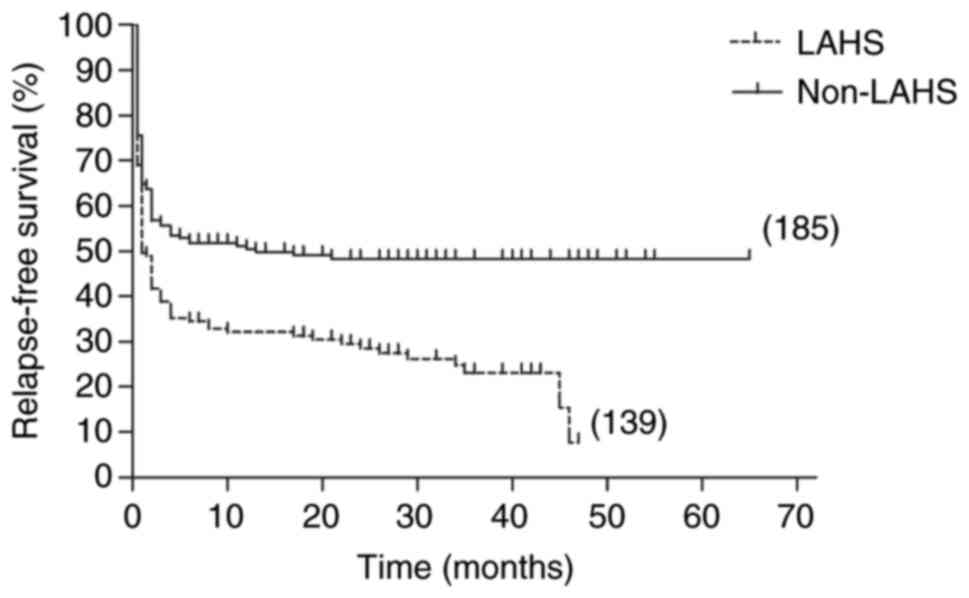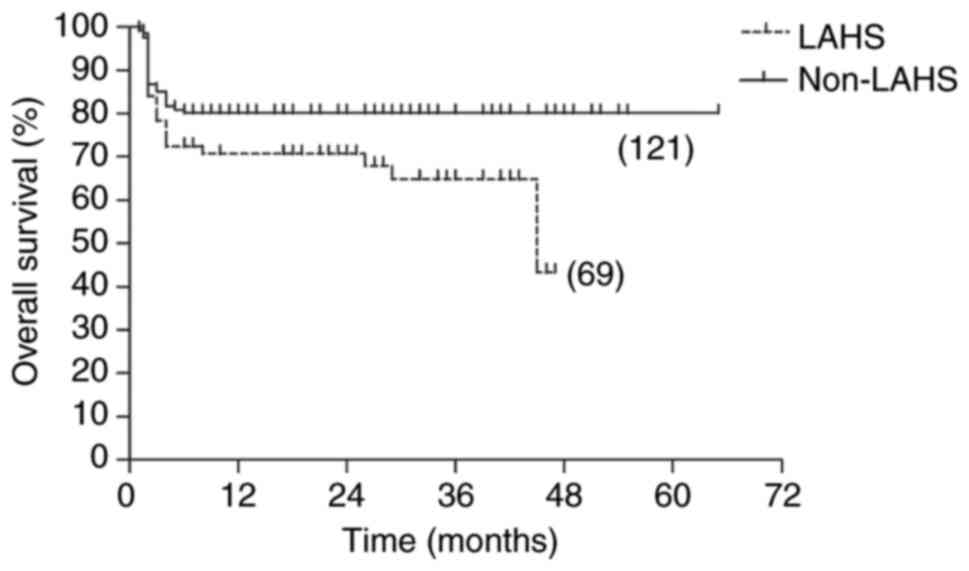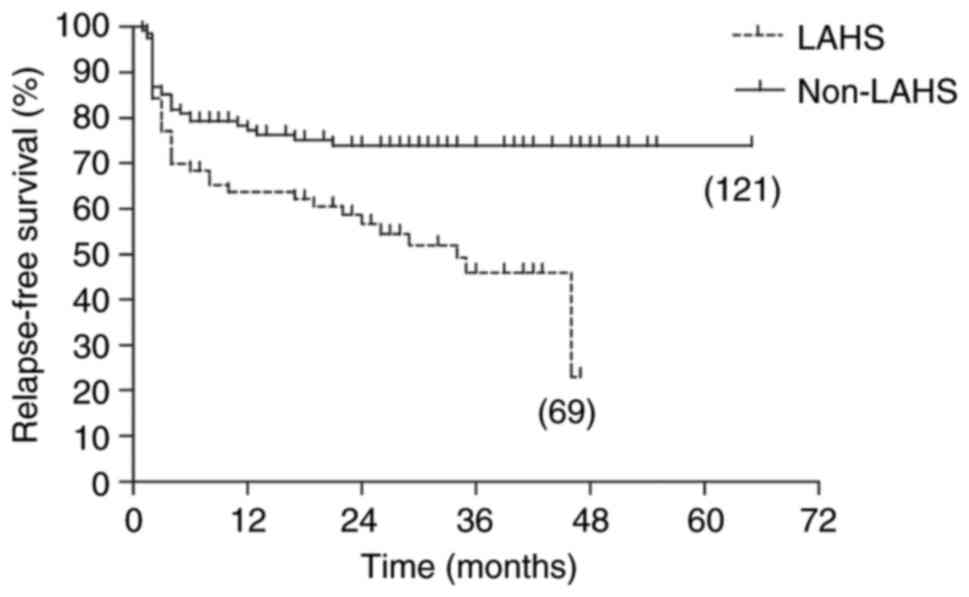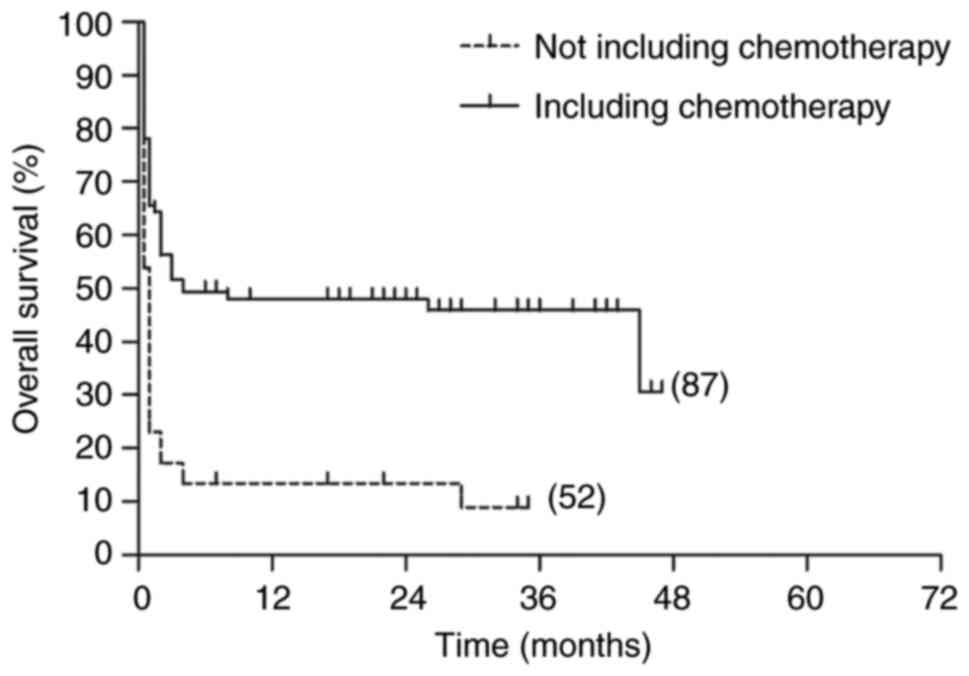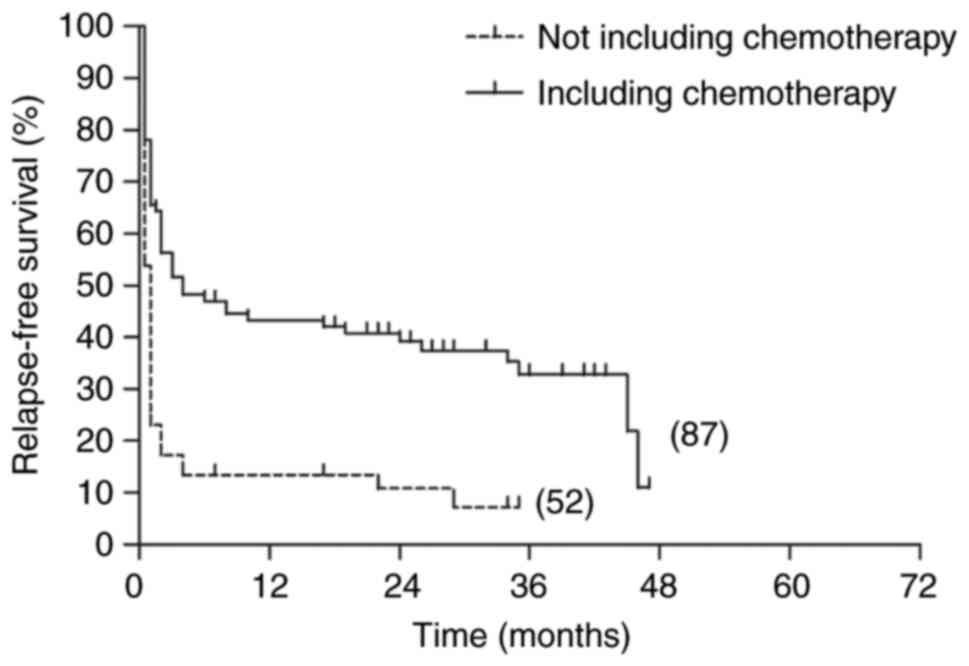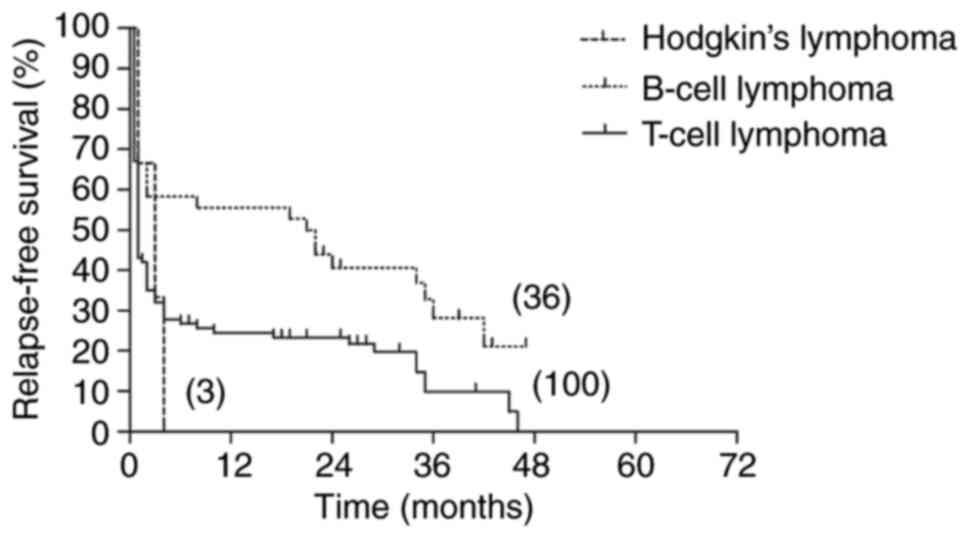Clinical features and prognostic analysis of lymphoma‑associated hemophagocytic syndrome: A report of 139 cases
- Authors:
- Published online on: November 17, 2022 https://doi.org/10.3892/ol.2022.13599
- Article Number: 13
Abstract
Introduction
Hemophagocytic syndrome (HPS), also known as hemophagocytic lymphohistiocytosis (HLH), is an immune-mediated syndrome with a typically rapid progression (1). HPS is a serious disease, the main clinical manifestations of which are fever, hemocytopenia, ferremia, hypertriglyceridemia, hepatosplenomegaly and hemophagocytosis affecting the bone marrow, liver, spleen or lymph nodes (2). HPS is classified into two distinct forms: Primary or familial HPS and secondary HPS. Secondary HPS may develop as a consequence of strong immune activation due to severe infections, malignancies or autoimmune diseases. Currently, the most common secondary HPS is lymphoma-associated HPS (LAHS), which has been reported in 20–67% of patients (3–5).
LAHS has been extensively described in occidental countries (6,7). However, there maybe marked differences between the Asian population and patients from western countries. It is notable that natural killer/T-cell lymphoma and T-cell lymphoma are rare in western countries but very common in Asian countries (6). In addition, the most common pathological type in Asian populations is NK/T-cell LAHS (NK/T-LAHS), which accounts for 35% of patients with LAHS (8).
There is no unified understanding of the clinical features and prognostic factors of LAHS. As the clinical manifestations and treatment response of LAHS are not only affected by HPS itself but are also associated with lymphoma, the prognosis is often poor (9,10). At present, there is no standard and effective first-line treatment for LAHS, although the HLH-1994 treatment protocol is the most widely used. However, a clinical study revealed that 30% of patients with HPS did not respond to the standard HLH-1994 regimen and died during the first few weeks of treatment, and the efficacy of this regimen in patients with LAHS was particularly poor (11). A study of 137 patients with HPS in Germany showed that the median survival duration of patients with idiopathic HPS was 248 days and that of patients with infection-associated HPS was 641 days (12). Chang et al (13) studied the prognosis of patients with LAHS and observed a median survival time of 43 days for all patients, with B-cell LAHS (B-LAHS) and NK/T-LAHS having median survival times of 55 and 40 days, respectively. Furthermore, Liu et al (14) also found that the prognosis of patients with NK/T-LAHS was poor, with a mortality rate of 96.4% and median survival time of only 15 days; its prognosis is worse than that of other types of HPS (3,6,9,15). In addition, a study of 567 patients with HPS in Japan between 2001 and 2005 showed that patients with NK/T-LAHS had the worst prognosis, with a 5-year survival rate of <15%, followed by familial HPS and B-LAHS (3). Numerous studies have confirmed that the prognosis of patients with LAHS is relatively poor (3–5,16,17).
Due to its rarity and the heterogeneity of inducing factors and clinical outcomes, the management of LAHS remains challenging. Few reports have focused on LAHS due to its low incidence rate. Therefore, the present study retrospectively analyzed the clinical features, treatment and prognosis of LAHS with the goal of providing valuable guidance for the diagnosis and treatment of patients with LAHS.
Patients and methods
Patients
The 139 patients with lymphoma and LAHS (LAHS group) and 185 patients with HPS that was not associated with lymphoma (non-LAHS group) who were admitted to The First Affiliated Hospital of Medical School of Zhejiang University (Hangzhou, China) and the Cancer Hospital of the University of Chinese Academy of Sciences (Hangzhou, China) between January 2014 and February 2021 were enrolled in the present study. These patients were retrospectively analyzed in a clinical study designated as ‘Lymphoma-Associated Hemophagocytic Syndrome’. All patients met the following inclusion criteria: Adolescent and adult patients aged ≥14 years; met the HLH-2004 diagnostic criteria (18); and evidence of malignant lymphoma for the LAHS group. Exclusion criteria: Did not meet the HLH-2004 diagnostic criteria or met the diagnostic criteria but had not received treatment; and no evidence of malignant lymphoma for the non-LAHS group. The diagnosis of malignant lymphoma was based on the 2008 World Health Organization classification. The medical records of all the diagnosed cases at their presentation to hospital were reviewed. The study was reviewed and approved by the ethics committees of The First Affiliated Hospital of Medical School of Zhejiang University and the Cancer Hospital Affiliated with the University of Chinese Academy of Sciences (ethical approval no.: IRB-2022-55). All patients provided written informed consent. The study was performed in accordance with The Declaration of Helsinki.
Diagnostic criteria
The diagnosis of HPS was based on the HLH-2004 protocol standard (Group 2004) (18). The patients were diagnosed with LAHS if they were pathologically diagnosed with lymphoma and met at least five of the following eight criteria: i) fever; ii) splenomegaly; iii) cytopenia affecting at least two lineages in the peripheral blood, defined as hemoglobin <90 g/l, platelets <100×109/l and neutrophils <1.0×109/l; iv) hypertriglyceridemia (triglycerides >3 mmol/l) and/or hypofibrinogenemia (fibrinogen <1.5 g/l); v) ferritin ≥500 µg/l; vi) soluble interleukin-2 receptor (sCD25) ≥2,400 U/ml; vii) decreased or absent NK-cell activity; and viii) hemophagocytosis in the bone marrow, spleen, liver or lymph nodes. NK cell activity and the level of sCD25 were not tested in the patients because suitable test methods were unavailable at the time of diagnosis. Most patients in the LAHS group presented with HPS at the diagnosis of lymphoma and a small number of patients developed HPS during the clinical course of lymphoma, typically at the advanced stage.
Laboratory examination
All patients underwent a physical examination and hematological tests, including a complete blood count, blood biochemical function test and coagulation function test. The percentage of macrophages in the bone marrow was also measured. Biopsy specimens from involved sites were assessed, as well as bone marrow smears and biopsies.
Therapeutic regimens
The patients received induction treatment with the HLH-1994 regimen. For patients with LAHS, once the HPS was controlled, the chemotherapy regimen appropriate for the type of lymphoma that was present was administered to treat the primary disease. The COPE or ECHOP (etoposide + dexamethasone + vindesine + cyclophosphamide + nordoxorubicin) regimen was mainly used for NK/T-cell lymphoma or T-cell lymphoma, the R-CHOP (rituximab + dexamethasone + vindesine + cyclophosphamide + nordoxorubicin) regimen was used for non-Hodgkin's B-cell lymphoma and the ABVD (epirubicin + bleomycin + vindesin + dacarbazine) regimen was used for Hodgkin's lymphoma. Patients with infections were treated with antibiotics and/or antiviral drugs. Blood transfusions included the transfusion of erythrocyte suspensions, platelets, fresh plasma and blood products.
Study endpoints and definitions
Early death was defined as mortality due to any cause within 30 days after the diagnosis of HPS. Overall survival (OS) and recurrence free survival (RFS) refer to the time from the diagnosis of HPS to patient death and diagnosis of HPS recurrence, respectively. All cases were followed up through outpatient re-examination or telephone interviews, and the follow-up was performed up to January 31, 2022.
Statistical analysis
Clinical and laboratory data were compared between the LAHS and non-LAHS groups using χ2 and Fisher's exact probability tests for frequency data and Mann-Whitney U test for age. Kaplan-Meier curves were used to calculate and analyze the OS rate. The differences in survival rates between groups were compared using the log-rank method. The Cox risk regression model was used to analyze the factors associated with LAHS via univariate analysis. The factors shown to be statistically significant by the univariate analysis were incorporated into a Cox risk regression model for multivariate analysis. P<0.05 was considered to indicate a statistically significant result. Statistical analysis was performed using SPSS 19 software (IBM Corp.).
Results
Patient characteristics
A total of 324 patients were included in the study. The clinical parameters of the patients are shown in Tables I and II. The male to female ratio was 1.4:1 and the median age was 50 years (range, 14–90 years). In the LAHS group, 119 patients developed HPS at the initial diagnosis of lymphoma and 20 patients developed HPS at the recurrence of lymphoma. Total bilirubin, indirect bilirubin, hepatomegaly and lymphadenopathy in the LAHS group were significantly higher compared with those in the non-LAHS group (P=0.005, P=0.006, P=0.009 and P=0.003, respectively; Table I). Age, sex, white blood cell count, hemoglobin and platelet level were not found to be significantly different between the LAHS and non-LAHS groups. During the follow-up, 134/324 (41.4%) patients died within 30 days after diagnosis. These early deaths were of 70/139 (50.4%) patients in the LAHS group and 64/185 (34.6%) patients in the non-LAHS group. In addition, 70/324 (21.6%) patients experienced a recurrence, including 42/139 (30.2%) patients in the LAHS group and 28/185 (15.1%) patients in the non-LAHS group. In the LAHS group, the most frequent histopathological subtypes were T-cell lymphoma in 100 patients (71.9%) and extranodal NK/T-cell lymphoma in 63 patients (45.3%), followed by diffuse large B-cell lymphoma in 27 patients (19.4%) and peripheral T-cell lymphoma in 15 patients (10.8%) (Table II). In the non-LAHS group, 17 (9.2%) patients had autoimmune disease and 32 (17.3%) had no confirmed basic diseases. There were also 33 (17.8%) patients with Epstein-Barr virus infection, 4 (2.2%) with cytomegalovirus, 86 (46.5%) with infection and 13 (7.0%) with potential hematological diseases.
Table II.Pathological subtypes of lymphoma of the 139 patients with lymphoma-associated hemophagocytic syndrome. |
Comparison of therapeutic response in the LAHS and non-LAHS groups
The patients in the LAHS group received five different treatments. Two patients received intravenous immunoglobulin (IVIG) alone (1.4%), 41 patients received glucocorticoid (GC) alone (29.5%), 10 patients received GC combined with IVIG (7.2%), 72 patients received GC combined with chemotherapy (51.8%), and 14 patients received GC combined with IVIG and chemotherapy (10.1%; Fig. 1). The patients in the non-LAHS group received HLH-2004 treatments.
Association between disease characteristics and early death in LASH
There were 70 early deaths of patients in the LAHS group. The analysis of various disease characteristics revealed that the early death rate was significantly higher in patients with a platelet count of ≤20.0×109/l, fibrinogen level of ≤1.5 g/l, activated partial thromboplastin time (APTT) of >36.0 sec, prothrombin time of >13.5 sec, lactate dehydrogenase (LDH) level of >1,000 U/l, ferritin level of >10,000 µg/l and splenomegaly (Table III).
Comparison of recurrence and survival between the LAHS and non-LAHS groups
The median follow-up time for the 324 patients was 12 months (interquartile range, 1–65 months). By the end of follow-up, 90 (64.7%) patients in the LAHS group had died and 70 (50.4%) of these deaths were defined as early mortality. The 5-year RFS and OS rates in the LAHS group were low at 7.7 and 21.5%, respectively. By contrast, the 5-year RFS and OS rates in the non-LAHS group were high at 48.3 and 52.4%, respectively. There was a significant difference in OS between the two groups as indicated by the log-rank test (P<0.001). In addition, the 5-year RFS in the LAHS group was significantly lower than that in the non-LAHS group (P<0.001). When patients who died early were excluded from the two groups, the 5-year OS rates were improved and significantly different (43.3 vs. 80.2; P=0.041), and the 5-year RFS rates also remained significantly different (22.9 vs. 73.8; P=0.002; Fig. 2, Fig. 3, Fig. 4, Fig. 5).
Univariate and multivariate analysis of early death in LAHS
Univariate analysis indicated that OS was significantly associated with coagulation dysfunction (APTT >36.0 sec), abnormal LDH (>1,000 U/l) and abnormal ferritin (>10,000 µg/l). The subsequent multivariate analysis revealed that coagulation dysfunction and abnormal LDH were independent prognostic indicators of reduced OS (Table IV).
Table IV.Univariate and multivariate analysis of the overall survival of patients with lymphoma-associated hemophagocytic syndrome. |
Survival rate comparison between LAHS patients with and without chemotherapy
The 5-year OS and RFS rates in the patients with LAHS who had received chemotherapy were 30.7 and 10.9%, respectively. By comparison, the 5-year OS and RFS rates in the patients with LAHS who had not received chemotherapy were very low at 8.9 and 7.2%, respectively. Log-rank tests showed that there was a significant difference in OS between the two groups (P<0.001), and that the 5-year RFS of patients who had not received chemotherapy was significantly lower than that of patients who had undergone chemotherapy (P<0.001; Figs. 6 and 7).
Survival rate comparison between patients with LAHS of different pathological subtypes
The 5-year OS and RFS rates in the B-cell lymphoma group were high at 58.3 and 21.1%, respectively. The 5-year OS and RFS rates in the T-cell lymphoma group were much lower, at 11.7 and 0% respectively. The 5-year OS and RFS rates in the Hodgkin's lymphoma group were both 0%. Log-rank tests identified a significant difference in OS among the three groups (P=0.022) and indicated that the 5-year RFS of patients in the B-cell lymphoma group was significantly higher than that of patients in the chemotherapy and Hodgkin's lymphoma groups (P=0.047; Figs. 8 and 9).
Discussion
Tumor-associated HPS most frequently occurs secondary to hematological malignancies, such as lymphoma (18). LAHS is a major subtype of secondary HPS with a poor outcome (9,19,20). Therefore, the identification of means for improving the survival rate of patients with LAHS is a key and challenging issue in the treatment of HPS, for which clinical data are lacking. The present study sought to investigate the clinical features and prognostic factors of patients with LAHS, with the aim of exploring individualized therapeutic strategies to reduce the recurrence rate and early mortality in patients with LAHS and to improve their long-term survival rate.
The present study retrospectively analyzed 324 patients who were diagnosed with HPS between January 2014 and February 2021. A total of 139 patients with LAHS were evaluated, accounting for 42.9% of the cohort, which was consistent with previous reports (20,21). Studies have shown that LAHS is most commonly secondary to diffuse large B-cell lymphoma in the Europe and Japan, but predominantly secondary to T-cell lymphoma in China and Korea (3,6,20). In the present study, LAHS was associated with T-LAHS in~71.9% of patients, which is in line with previous reports of 50.0-75.4% (13,21,22).
No significant differences in age, sex, white blood cell count, hemoglobin or platelet levels were detected between the LAHS and non-LAHS groups. The percentages of patients with a total bilirubin level of >21 µmol/l and indirect bilirubin level of >14 µmol/l in the LAHS group were significantly higher compared with those in the non-LAHS group. Previous studies have demonstrated that there is a significant difference in total bilirubin indicators between groups of patients with different prognostic factors, and the evident anomaly of various indicators is associated with disease-induced multiple organ function impairment (23,24). Therefore, these may be among the causes of the high early mortality rate in patients with LAHS. Hyperbilirubinemia is considered to be a risk factor of early death (25). Hepatomegaly and lymphadenopathy were also significantly different between the LAHS and non-LAHS groups in the present study, which was likely associated with secondary lymphoma in patients with LAHS. Notably, hepatomegaly is a risk factor for NK/T-LAHS (26).
In a previous study, Ishii et al (3) analyzed the outcomes of distinct subtypes of HPS, which revealed that the 5-year OS rates were 89.6% for autoimmune-associated HPS, 89.0% for other infection-associated HPS, 82.7% for Epstein-Barr virus-HPS, 48.2% for B-LAHS and 12.2% for NK/T-LAHS. The overall mortality associated with LAHS has been reported to be 79.6% (26). A study of 28 cases of T-LAHS reported that all patients died, with 89.0% deaths occurring within 6 months of diagnosis (9). The present study retrospectively analyzed the prognosis for 139 patients with LAHS. The OS of patients with LAHS was significantly lower than that in patients with non-LAHS (21.5 vs. 52.4%; P<0.001). However, when patients with early mortality were excluded, the difference in OS between the patients with and without LAHS appeared to decrease, as the difference was less significant (P=0.041). This shows that if LAHS patients can overcome early death, their OS improves significantly. Therefore, it is essential to reduce early mortality in order to improve the prognosis of patients with LAHS. At present, there is no unified standard treatment for LAHS, and the optimal therapeutic option remains largely undefined. Various therapeutic strategies have been reported, such as steroid pulse therapy, IVIG, the CHOP regimen, the HPS-2004 protocol, the HPS-94 protocol and CD25 monoclonal antibody treatment (6). However, the complexity of LAHS may delay the timing of the primary disease treatment, which is not conducive to a favorable outcome and the prognosis of the disease (27,28). Chemotherapy-resistant LAHS requires hematopoietic stem cell transplantation (7,9,13,29). The median survival time for patients with LAHS who do not receive chemotherapy has been reported to be only 11 days (30). In the present study, 61.9% of the patients with LAHS received a chemotherapy regimen. The 5-year OS and RFS of patients who received chemotherapy were significantly higher than those in the patients who did not receive chemotherapy. The aggressive treatment of primary tumors in cases of tumor-associated HPS has been recommended (13,27,31). Although the current study focused on a small number of patients, it indicates that chemotherapy for lymphoma has great potential in the treatment of LAHS, and can improve patient prognosis.
Early mortality continues to be the main factor affecting the efficacy of HPS. The mortality associated with LAHS is notably high. Therefore, early treatment with intensive chemotherapy is critical for improving OS. In the present study, the early mortality of patients with LAHS was significantly higher than that of the patients in the non-LAHS group (50.4 vs. 34.6%; P=0.004). Jin et al (27) reported an early (30-day) mortality rate of 51.1% for patients with NK/T-LAHS. Other studies have reported a median survival time for patients with T-LAHS ranging from 11 to 40 days (9,30,32). Hence, it is clear that LAHS is dangerous and the early stage of the disease is the time at which the risk of death is greatest. The present study further analyzed the risk factors associated with early death. Univariate analysis indicated that OS was significantly associated with coagulation dysfunction (>36.0 sec), abnormal LDH (>1,000 U/l) and abnormal ferritin (>10,000 µg/l). Multivariate analysis indicated that coagulation dysfunction and abnormal LDH were independent prognostic indicators of reduced OS, which was consistent with previous research (27,33–35). Disseminated intravascular coagulation (DIC) caused by coagulation dysfunction is one of the main causes of HPS-associated death (9,36–38). Patients with T-LAHS are prone to DIC, while the association of B-LAHS with DIC is less common (39). Li et al (26) found that 10 cases of early death among 103 patients with HPS were complicated by DIC. Therefore, the early detection of coagulation abnormalities, the timely correction and prevention of DIC and thus the reduction of early mortality are critical (26). For this group of patients, early use of the CHOP regimen to treat LAHS is recommended, in order to suppress inflammation, prevent severe coagulopathy and severe infections and minimize early mortality, thereby achieving better results.
The present study has some limitations. Firstly, it is a retrospective study that is based on the analysis of medical records, which may have some bias. Secondly, the detection of sCD25 and NK cell activity were not performed. Another limitation is that immortal time bias was not accounted for.
In summary, the onset of LAHS is dangerous. LAHS has a high early mortality rate and the prognosis of patients with LAHS is significantly worse than that of patients with other types of HPS. Once LAHS has been diagnosed, the treatment of lymphoma is particularly important. Since the mortality associated with LAHS is high, the early recognition and treatment of DIC and reduction of early mortality rate are critical for improving OS.
Acknowledgements
Not applicable.
Funding
This study was partly supported by Zhejiang Provincial Public Welfare Technology Application Research and Subsidy Project (grant no. LGF19H080003) and Zhejiang Medical and Health Science and Technology Program (grant no. 2020ky1071).
Availability of data and materials
The datasets used and/or analyzed during the current study are available from the corresponding author on reasonable request.
Authors' contributions
QZ collected, analyzed and interpreted the data and drafted the manuscript. LW collected, analyzed and interpreted the data and revised the manuscript. DZ performed statistical analyses, interpreted the data and revised the manuscript. LZ, LL and WX obtained the samples and added clinical data in the process of article repair. YT obtained the samples, added clinical data in the process of article repair and reviewed the manuscript. XY conceived and coordinated the study, designed and analyzed the experiments, reviewed the paper and gave final approval for the submitted version. QZ and XY confirm the authenticity of all the raw data. All authors read and approved the final manuscript.
Ethics approval and consent to participate
This study was approved by the Cancer Hospital of the University of Chinese Academy of Sciences (Hangzhou, China). All patients provided written informed consent to participate.
Patient consent for publication
All patients consented to publication of their data.
Competing interests
The authors declare that they have no competing interests.
References
|
Canna SW and Marsh RA: Pediatric hemophagocytic lymphohistiocytosis. Blood. 135:1332–1343. 2020. View Article : Google Scholar : PubMed/NCBI | |
|
Liu P, Pan X, Chen C, Niu T, Shuai X, Wang J, Chen X, Liu J, Guo Y, Xie L, et al: Nivolumab treatment of relapsed/refractory Epstein-Barr virus-associated hemophagocytic lymphohistiocytosis in adults. Blood. 135:826–833. 2020. View Article : Google Scholar : PubMed/NCBI | |
|
Ishii E, Ohga S, Imashuku S, Yasukawa M, Tsuda H, Miura I, Yamamoto K, Horiuchi H, Takada K, Ohshima K, et al: Nationwide survey of hemophagocytic lymphohistiocytosis in Japan. Int J Hematol. 86:58–65. 2007. View Article : Google Scholar : PubMed/NCBI | |
|
Yao S, Jin Z, He L, Zhang R, Liu M, Hua Z, Wang Z and Wang Y: Clinical features and prognostic risk prediction of non-Hodgkin lymphoma-associated hemophagocytic syndrome. Front Onco. 11:7880562021. View Article : Google Scholar : PubMed/NCBI | |
|
Lin CH, Shih YH, Chen TC, Chou CW, Hsu CY and Teng CJ: A decade of lymphoma-associated hemophagocytic lymphohistiocytosis: Does the outcome improve? J Clin Med. 10:51142021. View Article : Google Scholar : PubMed/NCBI | |
|
Bigenwald C, Fardet L, Coppo P, Meignin V, Lazure T, Fabiani B, Kohn M, Oksenhendler E, Boutboul D, Uzzan M, et al: A comprehensive analysis of Lymphoma-associated haemophagocytic syndrome in a large French multicentre cohort detects some clues to improve prognosis. Br J Haematol. 183:68–75. 2018. View Article : Google Scholar : PubMed/NCBI | |
|
Giza A, Gałązka K, Jońca M, Raźny M, Zimowska-Curyło D, Wilk M, Goldman-Mazur S, Piątkowska-Jakubas B and Sacha T: Subcutaneous panniculitis-like T-cell lymphoma (SPTCL) with probable mesentery involvement with associated hemophagocytic syndrome (HPS)-how to treat it? J Dermatolog Trea. 33:2674–2676. 2022. View Article : Google Scholar : PubMed/NCBI | |
|
Lehmberg K, Nichols KE, Henter JI, Girschikofsky M, Greenwood T, Jordan M, Kumar A, Minkov M, La Rosée P and Weitzman S; Study Group on Hemophagocytic Lymphohistiocytosis Subtypes of the Histiocyte Society, : Consensus recommendations for the diagnosis and management of hemophagocytic lymphohistiocytosis associated with malignancies. Haematologic. 100:997–1004. 2015.PubMed/NCBI | |
|
Tong H, Ren Y, Liu H, Xiao F, Mai W, Meng H, Qian W, Huang J, Mao L, Tong Y, et al: Clinical characteristics of T-cell lymphoma associated with hemophagocytic syndrome: Comparison of T-cell lymphoma with and without hemophagocytic syndrome. Leuk Lymphoma. 49:81–87. 2008. View Article : Google Scholar : PubMed/NCBI | |
|
Song Y, Yin Q, Wang J and Wang Z: Autologous hematopoietic stem cell transplantation for patients with lymphoma-associated hemophagocytic lymphohistiocytosis. Cell Transplant. 30:96368972110570772021. View Article : Google Scholar : PubMed/NCBI | |
|
Henter JL, Samuelsson-Horne AC, Aricò M, Egeler RM, Elinder G, Filipovich AH, Gadner H, Imashuku S, Komp D, Ladisch S, et al: Treatment of hemophagocytic lymphohistiocytosis with HLH-94 immunochemotherapy and bone marrow transplantation. Blood. 100:2367–2373. 2002. View Article : Google Scholar : PubMed/NCBI | |
|
Birndt S, Schenk T, Heinevetter B, Brunkhorst FM, Maschmeyer G, Rothmann F, Weber T, Müller M, Panse J, Penack O, et al: Hemophagocytic lymphohistiocytosis in adults: Collaborative analysis of 137 cases of a nationwide German registry. J Cancer Res Clin Onco. 146:1065–1077. 2020. View Article : Google Scholar : PubMed/NCBI | |
|
Chang Y, Cui M, Fu X, Han L, Zhang L, Li L, Li X, Sun Z, Wu J, Zhang X, et al: Lymphoma associated hemophagocytic syndrome: A single-center retrospective study. Oncol Lett. 16:1275–1284. 2018.PubMed/NCBI | |
|
Liu YZ, Bi LQ, Chang GL, Guo Y and Sun S: Clinical characteristics of extranodal NK/T-cell lymphoma-associated hemophagocytic lymphohistiocytosis. Cancer Manag Res. 11:997–1002. 2019. View Article : Google Scholar : PubMed/NCBI | |
|
Daver N, McClain K, Allen CE, Parikh SA, Otrock Z, Rojas-Hernandez C, Blechacz B, Wang S, Minkov M, Jordan MB, et al: A consensus review on malignancy-associated hemophagocytic lymphohistiocytosis in adults. Cancer. 123:3229–3240. 2017. View Article : Google Scholar : PubMed/NCBI | |
|
Ren Q, Chan KW, Huang H, Wang Z, Fang X, Guo C, Li F, Zhang L, Yao Y, Chen Z, et al: Platelet-derived alpha-granules are associated with inflammation in patients with NK/T-cell lymphoma-associated hemophagocytic syndrome. Cytokine. 126:1548782020. View Article : Google Scholar : PubMed/NCBI | |
|
Meng G, Wang Y, Wang J and Wang Z: The DEP regimen is superior to the HLH-1994 regimen as first-line therapy for lymphoma-associated haemophagocytic lymphohistiocytosis. Leuk Lymphoma. 62:854–860. 2021. View Article : Google Scholar : PubMed/NCBI | |
|
Henter JI, Horne A, Aricó M, Egeler RM, Filipovich AH, Imashuku S, Ladisch S, McClain K, Webb D, Winiarski J and Janka G: HLH-2004: Diagnostic and therapeutic guidelines for hemophagocytic lymphohistiocytosis. Pediatr Blood Cancer. 48:124–131. 2007. View Article : Google Scholar : PubMed/NCBI | |
|
Jin Z, Wang Y, Wei N and Wang Z: Hodgkin lymphoma-associated hemophagocytic lymphohistiocytosis-a dangerous disease. Ann Hematol. 99:1575–1581. 2020. View Article : Google Scholar : PubMed/NCBI | |
|
Pasvolsky O, Zoref-Lorenz A, Abadi U, Geiger KR, Hayman L, Vaxman I, Raanani P and Leader A: Hemophagocytic lymphohistiocytosis as a harbinger of aggressive lymphoma: A case series. Int J Hematol. 109:553–562. 2019. View Article : Google Scholar : PubMed/NCBI | |
|
Li W, Zhong Y, Shuang Y, Huang H, Huang Y, Yu L and Huang X: High concentration of miR-133 is a useful marker for the diagnosis of lymphoma-associated hemophagocytic syndrome. Cancer Biomark. 20:159–164. 2017. View Article : Google Scholar : PubMed/NCBI | |
|
Yuan S, Wang Y, Luo H, Jiang Z, Qiao B, Jiang Y, Hu Y, Cheng Y, Chen X, Gong W, et al: Serum soluble VSIG4 as a surrogate marker for the diagnosis of lymphoma-associated hemophagocytic lymphohistiocytosis. Br J Haematol. 189:72–83. 2020. View Article : Google Scholar : PubMed/NCBI | |
|
Bin Q, Gao JH and Luo JM: Prognostic factors of early outcome in pediatric hemophagocytic lymphohistiocytosis: An analysis of 116 cases. Ann Hematol. 95:1411–1418. 2016. View Article : Google Scholar : PubMed/NCBI | |
|
George MR: Hemophagocytic lymphohistiocytosis: Review of etiologies and management. J Blood Med. 5:69–86. 2014. View Article : Google Scholar : PubMed/NCBI | |
|
Prokesch BC, Nagalla S, Ezzati F, Tujios SR, Dominguez A, Chen W, Kershaw C, Patel P, de la Flor C, Foster J, et al: What's in a name? The heterogeneous clinical spectrum and prognostic factors in a cohort of adults with hemophagocytic lymphohistiocytosis. Transfus Apher Sci. 57:779–784. 2018. View Article : Google Scholar : PubMed/NCBI | |
|
Li J, Wang Q, Zheng W, Ma J, Zhang W, Wang W and Tian X: Hemophagocytic lymphohistiocytosis: Clinical analysis of 103 adult patients. Medicine (Baltimore). 93:100–105. 2014. View Article : Google Scholar : PubMed/NCBI | |
|
Jin Z, Wang Y, Wang J, Wu L, Pei R, Lai W and Wang Z: Multivariate analysis of prognosis for patients with natural killer/T cell lymphoma-associated hemophagocytic lymphohistiocytosis. Hematology. 23:228–234. 2018. View Article : Google Scholar : PubMed/NCBI | |
|
Bhatt NS, Oshrine B and An Talano J: Hemophagocytic lymphohistiocytosis in adults. Leuk Lymphoma. 60:19–28. 2019. View Article : Google Scholar : PubMed/NCBI | |
|
Lee DE, Martinez-Escala ME, Serrano LM, Zhou XA, Kaplan JB, Pro B, Choi J and Guitart J: Hemophagocytic lymphohistiocytosis in cutaneous T-cell lymphoma. JAMA Dermatol. 154:828–831. 2018. View Article : Google Scholar : PubMed/NCBI | |
|
Takahashi N, Chubachi A, Miura I, Nakamura S and Miura AB: Lymphoma-associated hemophagocytic syndrome in Japan. Rinsho Ketsueki. 40:542–549. 1999.(In Japanese). PubMed/NCBI | |
|
Malkan UY, Albayrak M, Yildiz M, Maral S, Afacan Ozturk HB and Comert P: A rare case of diffuse large B-cell lymphoma-associated hemophagocytic lymphohistiocytosis. J Oncol Pharm Pract. 27:250–252. 2021. View Article : Google Scholar : PubMed/NCBI | |
|
Han L, Li L, Wu J, Li X, Zhang L, Wang X, Fu X, Ma W, Sun Z, Zhang X, et al: Clinical features and treatment of natural killer/T cell lymphoma associated with hemophagocytic syndrome: Comparison with other T cell lymphoma associated with hemophagocytic syndrome. Leuk Lymphoma. 55:2048–2055. 2014. View Article : Google Scholar : PubMed/NCBI | |
|
Signoff JK, Fitzgerald JC, Teachey DT, Balamuth F and Weiss SL: Hypofibrinogenemia is associated with poor outcome and secondary hemophagocytic lymphohistiocytosis/macrophage activation syndrome in pediatric severe sepsis. Pediatr Crit Care Med. 19:397–405. 2018. View Article : Google Scholar : PubMed/NCBI | |
|
Li N, Zhang L, Liu J, Zhang J, Weng HW, Zhuo HY and Zou LQ: A clinical study of 21 patients with hemophagocytic syndrome in 295 cases diagnosed with nasal type, extranodal nature killer/T cell lymphoma. Cancer Biol Ther. 18:252–256. 2017. View Article : Google Scholar : PubMed/NCBI | |
|
Jiang T, Ding X and Lu W: The prognostic significance of beta2 microglobulin in patients with hemophagocytic lymphohistiocytosis. Dis Markers. 2016:15239592016. View Article : Google Scholar : PubMed/NCBI | |
|
Pan H, Huo Y and Sun L: Comparison between clinical features and prognosis of malignancy- and non-malignancy-associated pediatric hemophagocytic lymphohistiocytosis. BMC Pediatr. 19:4682019. View Article : Google Scholar : PubMed/NCBI | |
|
Valade S, Mariotte E and Azoulay E: Coagulation disorders in hemophagocytic lymphohistiocytosis/macrophage activation syndrome. Crit Care Clin. 36:415–426. 2020. View Article : Google Scholar : PubMed/NCBI | |
|
Jia J, Song Y, Lin N, Liu W, Ping L, Zheng W, Wang X, Xie Y, Tu M, Zhang C, et al: Clinical features and survival of extranodal natural killer/T cell lymphoma with and without hemophagocytic syndrome. Ann Hematol. 95:2023–2031. 2016. View Article : Google Scholar : PubMed/NCBI | |
|
Uni M, Yoshimi A, Maki H, Maeda D, Nakazaki K, Nakamura F, Fukayama M and Kurokawa M: Successful treatment with recombinant thrombomodulin for B-cell lymphoma-associated hemophagocytic syndrome complicated by disseminated intravascular coagulation. Int J Clin Exp Pathol. 6:1190–1194. 2013.PubMed/NCBI |





